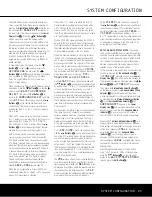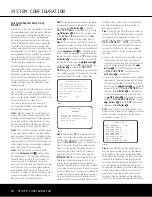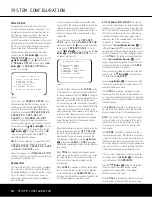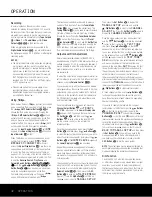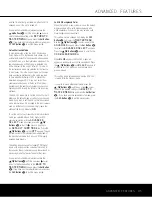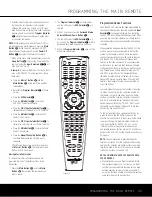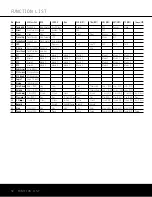
38 OPERATION
OPERATION
speakers are capable of reproducing low frequencies,
and when you wish to hear the analog source material
in its pure form.
Digital Audio Playback
Digital audio is a major advancement over older analog
surround processing systems. It delivers five, six or seven
discrete channels: left front, center, right front, left sur-
round, right surround and optionally one or two surround
back channels. Each channel reproduces full frequency
range (20Hz to 20kHz) and offers dramatically improved
dynamic range and significant improvements to signal-
to-noise ratios. In addition, digital systems have the capa-
bility to deliver an additional channel that is specifically
devoted to low-frequency information. This is the “.1”
channel referred to when you see these systems
described as “5.1,” “6.1” or “7.1”. The bass channel
is separate from the other channels, but since it is
intentionally bandwidth-limited, sound designers have
given it that unique designation.
Dolby Digital
Dolby Digital is a standard part of DVD, available on spe-
cially encoded LD discs and satellite broadcasts, and is a
part of the high-definition television (HDTV) system.
An optional, external RF demodulator is required to
use the AVR 340 to listen to the Dolby Digital sound-
tracks available on laser discs. Connect the RF output
of the LD player to the demodulator and then connect
the digital output of the demodulator to the
Optical
or
Coaxial Inputs
*(
fif
of the AVR 340. No
demodulator is required for use with DVD players or
DTS-encoded laser discs.
DTS
DTS is another digital audio system that is capable of
delivering 5.1 or 6.1 discrete or matrix sound field
reproduction. Although both DTS and Dolby Digital are
digital, they use different methods of encoding the sig-
nals, and thus they require different decoding circuits
to convert the digital signals back to analog.
DTS-encoded soundtracks are available on select DVD
and LD discs, as well as on special audio-only DTS
discs. You may use any LD or CD player equipped
with a digital output to play DTS-encoded discs with
the AVR 340. All that is required is to connect the
player’s output to either an
Optical
or
Coaxial Input
on the rear panel
fif
or front panel
*(
.
In order to listen to DVDs encoded with DTS sound-
tracks, the DVD player must be compatible with the
DTS signal as indicated by a DTS logo on the player’s
front panel. Early DVD players may not be able to play
DTS-encoded DVDs. This does not indicate a problem
with the AVR 340, as some players cannot pass the
DTS signal through to the digital outputs. If you are in
doubt as to the capability of your DVD player to handle
DTS discs, consult the player’s owner’s manual.
IMPORTANT NOTE:
Many DVD players have a default
setting that does not pass through the DTS data, even
though the machine is capable of doing so. If your
DVD player has the “DTS Digital Out” logo but does
not trigger DTS playback in the AVR 340, change the
player's settings in the “Audio” or “Bitstream” configu-
ration menu so that DTS playback is enabled. The
method for doing this will vary with each player. In
some cases, the proper menu choice will be “Original,”
while in others it will be “DTS.” Consult the owner's
manual for your player to find the specific information
to find the proper setting.
Selecting a Digital Source
To utilize either digital mode, you must have properly
connected a digital source to the AVR 340. Connect
the digital outputs from DVD players, HDTV receivers,
satellite systems or CD players to the
Optical
or
Coaxial Inputs
*(
fif
. In order to provide a
backup signal and a source for analog stereo recording
and multiroom operation, the analog outputs provided
on digital source equipment should also be connected
to their appropriate inputs on the AVR 340 rear panel
(e.g., connect the analog stereo audio output from a
DVD to the
DVD Audio Inputs
Z
on the rear panel
when you connect the source’s digital outputs).
If you have not already configured an input for a digital
source using the on-screen menus as shown on page
22, first select the input using the remote or front-
panel controls as outlined in this manual. Next, select
the digital source by pressing the
Digital Select
Button
q#
and then using the
⁄
/
¤
Buttons
n
on the remote or the
‹
/
›
Buttons
)
on the
front panel to choose any of the
OPTICAL
or
COAXIAL
inputs, as they appear in the
Upper
Display Line
P
or on-screen display. When the dig-
ital source is playing, the AVR 340 will automatically
detect which type of digital data stream is being
decoded and display that information in the
Upper
Display Line
P
.
The AVR 340’s Auto Polling feature searches both the
digital and analog audio inputs assigned to a source
for an incoming signal. Although the digital input is the
default, if the digital stream is not present or is inter-
rupted, the unit will automatically switch over to the
analog inputs. If you wish to disable the auto-polling
feature for any source, follow the instructions shown in
the Input Setup section of this manual on page 23.
Digital Bitstream Indications
When a digital source is playing, the AVR 340 senses
the type of bitstream data that is present. Using this
information, the correct surround mode will automati-
cally be selected. For example, DTS bitstreams will
cause the unit to switch to DTS decoding, and Dolby
Digital bitstreams will enable Dolby Digital decoding.
When the unit senses PCM data from CDs or LDs,
it will default to Logic 7 Music mode, although you
may select any of the standard surround modes, such
as Dolby Pro Logic II or Logic 7. Since the range of
available surround modes is dependent on the type of
digital data that is present, the AVR 340 uses a variety
of indicators and messages to let you know what type
of signal is present. These messages will appear shortly
after an input or surround mode is changed, and they
will remain in the
Lower Display Line
ı
for about
five seconds before that portion of the display returns
to the normal surround mode indication.
Surround Mode Channel Indications
For Dolby Digital and DTS sources, a three-digit indi-
cation will appear, showing the number of channels
present in the data. An example of this type of display
is
3/2/.1
.
The first number indicates how many discrete front
channel signals are present.
• A “3” tells you that separate front left, center and
front right signals are available. This will be displayed
for 5.1- and 6.1-channel Dolby Digital and DTS
programs.
• A “2” tells you that separate front left and right
signals are available, but there is no discrete center
channel signal. This will be displayed for bitstreams
that have stereo program material.
• A “1” tells you that there is only a mono channel
available in the bitstream.
The middle number indicates how many discrete sur-
round channel signals are present.
• A “2” tells you that separate surround left and right
signals are available. This will be displayed for 5.1-
and 6.1-channel Dolby Digital and DTS programs.
• A “1” tells you that there is only a single, surround-
encoded surround channel. This will appear for
Dolby Digital bitstreams that have matrix encoding.
• A “0” indicates that there is no surround channel
information. This will be displayed for 2-channel
stereo programs.
NOTE:
The surround back channels in 6.1-/7.1-chan-
nel bitstreams, such as Dolby Digital EX and DTS-ES
Discrete and Matrix programs, are not indicated using
this numbering system. Instead, a message will appear
to indicate whether EX or ES information is present
(see below).
The last number indicates whether there is a discrete
low-frequency effects (LFE) channel. This is the “.1”
in the common abbreviation of “5.1” sound and is a
special channel that contains only bass frequencies.
• A “1” tells you that an LFE channel is present.
This will be displayed for Dolby Digital and DTS
programs, as available.
AVR 340 OM 3/22/06 9:09 AM Page 38
Summary of Contents for AVR 340
Page 67: ......


